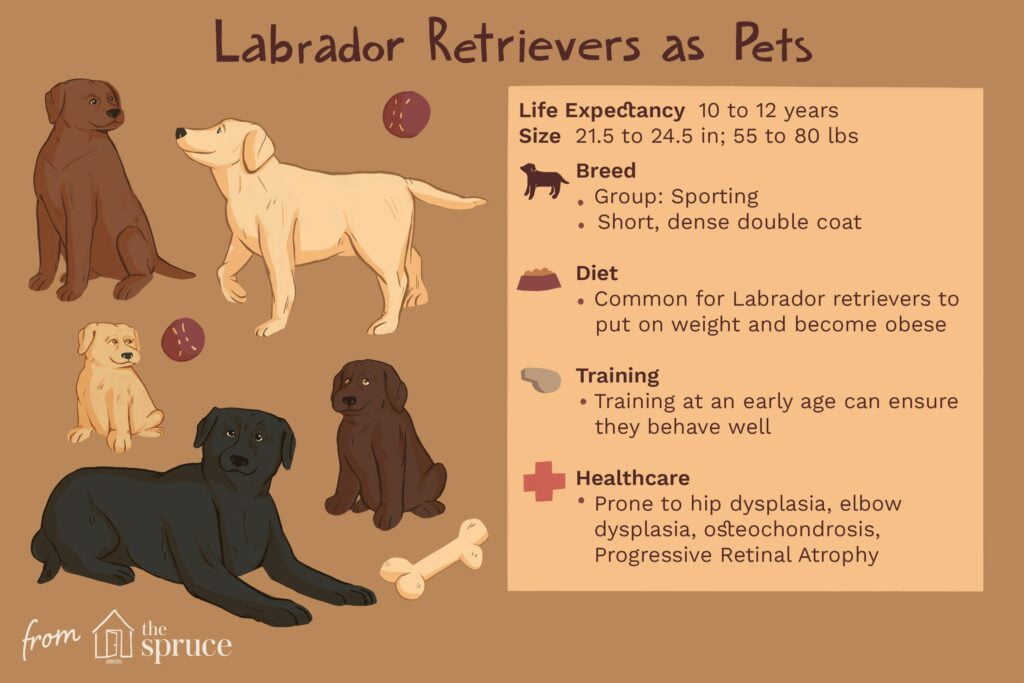Table of Contents
The Labrador Retriever is one of the most popular dog breeds worldwide, known for their friendly temperament, intelligence, and versatility. This guide provides a comprehensive profile of the Labrador Retriever breed, covering their temperament, physical traits, care needs, and more.

1. Temperament: Profile of Labrador Retriever Breed
Labrador Retrievers are renowned for their friendly and outgoing nature. They are highly social, enjoy being around people, and get along well with children and other pets. Their gentle and patient demeanor makes them excellent family pets.
- Tip: Socialize your Labrador Retriever early to ensure they develop into well-rounded adults. For more information, visit AKC.
2. Physical Traits
Labrador Retrievers are medium to large-sized dogs with a strong and athletic build. They have a short, dense double coat that is water-resistant, aiding their history as waterfowl retrievers. Labs come in three standard colors: black, yellow, and chocolate.
- Tip: Regular grooming helps manage shedding and keeps their coat healthy. For more tips, visit Hill’s Pet.
3. Exercise Needs: Profile of Labrador Retriever Breed
Labradors are energetic and require ample exercise to stay healthy and happy. Daily walks, playtime, and mental stimulation are essential to meet their needs. They excel in activities such as fetching, swimming, and agility training.
- Tip: Engage your Lab in regular exercise to prevent boredom and promote physical health. For more advice, visit AKC.
4. Training and Intelligence
Labrador Retrievers are highly intelligent and eager to please, making them easy to train. They respond well to positive reinforcement techniques and thrive on consistency and praise.
- Tip: Start training your Lab early, focusing on basic commands and gradually progressing to more advanced training. For more tips, visit PetMD.
5. Health and Lifespan: Profile of Labrador Retriever Breed
Labradors are generally healthy dogs with a lifespan of 10-12 years. However, they are prone to certain health conditions such as hip dysplasia, elbow dysplasia, and obesity. Regular veterinary check-ups are crucial to maintaining their health.
- Tip: Monitor your Lab’s weight and provide a balanced diet to prevent obesity. For more information, visit Cornell Feline Health Center.
6. Nutritional Needs
Proper nutrition is vital for the health and well-being of Labrador Retrievers. They require a balanced diet rich in proteins, fats, and essential nutrients. Portion control is important to prevent overfeeding and manage weight.
- Tip: Consult your veterinarian to determine the best diet for your Lab based on their age, weight, and activity level. For more advice, visit Hill’s Pet.
7. Grooming: Profile of Labrador Retriever Breed
Labradors have a short, dense coat that requires regular grooming to manage shedding and maintain skin health. Weekly brushing and occasional baths are typically sufficient.
- Tip: Use a deshedding tool to reduce loose hair and keep your Lab’s coat healthy. For more tips, visit AKC.
8. Adaptability
Labrador Retrievers are highly adaptable and can thrive in various living environments, from apartments to large homes with yards. They are resilient and can adjust to different climates and lifestyles.
- Tip: Ensure your Lab gets enough exercise and mental stimulation, regardless of your living situation. For more advice, visit PetMD.
9. Socialization: Profile of Labrador Retriever Breed
Proper socialization is essential for Labradors to develop into well-mannered adults. Expose them to various people, pets, and environments from a young age to build their confidence and social skills.
- Tip: Enroll your Lab in puppy socialization classes to help them learn how to interact appropriately with others. For more tips, visit AKC.
10. Lifespan and Aging: Profile of Labrador Retriever Breed
Labradors typically live between 10 to 12 years, but with proper care, they can live longer. As they age, they may require more frequent veterinary visits and specialized care to manage age-related health issues.
- Tip: Monitor your senior Lab for any changes in behavior, appetite, or mobility. For more advice, visit ASPCA.
Conclusion: Profile of Labrador Retriever Breed
The profile of the Labrador Retriever breed highlights their friendly temperament, intelligence, and versatility. With proper care, training, and socialization, Labradors make wonderful family pets and companions. For more tips on dog care and breeds, visit our website.
Frequently Asked Questions about Labrador Retrievers
Are Labrador Retrievers good with children?
Yes, Labradors are known for their friendly and patient nature, making them excellent companions for children. For more information, visit AKC.
How much exercise do Labrador Retrievers need?
Labradors require at least an hour of exercise daily. Activities like walking, fetching, and swimming are great ways to keep them active. For more tips, visit PetMD.
Do Labrador Retrievers shed a lot?
Yes, Labradors shed year-round, with increased shedding during seasonal changes. Regular grooming can help manage shedding. For more advice, visit Hill’s Pet.
What health issues are common in Labrador Retrievers?
Common health issues in Labradors include hip dysplasia, elbow dysplasia, and obesity. Regular veterinary check-ups and a balanced diet can help manage these conditions. For more information, visit Cornell Feline Health Center.
How can I train my Labrador Retriever effectively?
Labradors are intelligent and respond well to positive reinforcement. Start with basic commands and gradually introduce more complex training. Consistency and patience are key. For more tips, visit PetMD.











